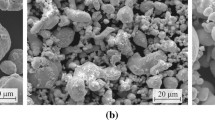The behavior of a mixture of oxide powders during pressing of green bodies is investigated. The entire pressing process can be divided conventionally into three main stages differing by the stability of the ensemble of structural elements of compaction and the possibility of configurational rearrangement or failure of these elements at the critical values of the external forces. A method is proposed for determining the optimal pressure; the method can be classed as an express method because this pressure is determined for green bodies.









Similar content being viewed by others
References
V. G. Pogosov, Principles of the Technology of Hydrostatic Pressing of the Piezoceramic System TSTS, Author’s Abstract of Candidate’s Thesis [in Russian], Chernogolovka (1984).
A. V. Belyakov, “Technology of machine engineering ceramics,” Itogi Nauki Tekhniki, Tekhnol. Silikatov Tugoplavkikh Nemetall. Mater., 1, 3 – 71 (1988).
L. M. Katsnel’son, Nature of the ‘Memory’ Effect of the Dispersion-Crystalline State in a Piezoceramic, Author’s Abstract of Candidate’s Thesis [in Russian], Rostov-on-Don (1996).
Author information
Authors and Affiliations
Corresponding author
Additional information
Translated from Steklo i Keramika, No. 9, pp. 8 – 13, September, 2013.
Rights and permissions
About this article
Cite this article
Katsnel’son, L.M., Kerbel’, B.M. Determination of the Optimal Uniaxial Pressing Pressure for Ceramic Powders. Glass Ceram 70, 319–323 (2014). https://doi.org/10.1007/s10717-014-9571-8
Published:
Issue Date:
DOI: https://doi.org/10.1007/s10717-014-9571-8




